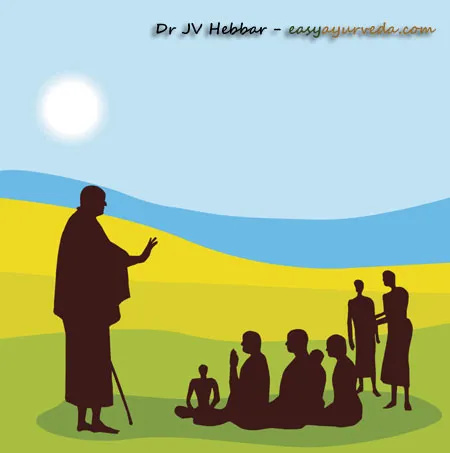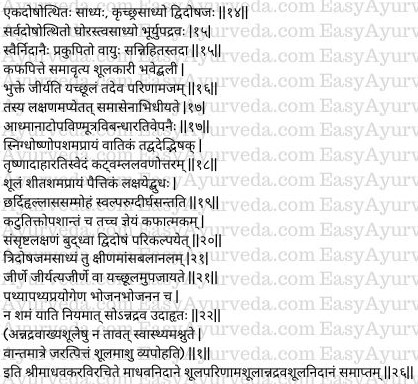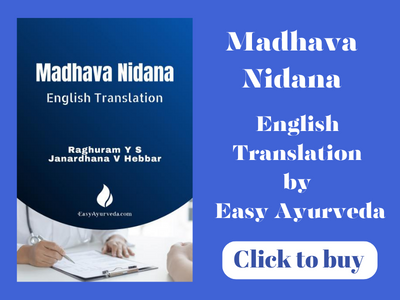Madhava Nidana Chapter 26 Shula Parinama shoola Annadrava shula Nidanam

This article explains Madava nidana 26th chapter “Shula Parinamashula Annadravashula Nidanam”. Causes, pathology and symptoms of Shula, Parinama shoola and Annadrava shoola are explained in this chapter.
Read – Acharya Madhavakara: His Work ‘Madhava Nidana’, Legacy, Amazing Facts

Table of Contents
Types of Sula

Shula (colic, pain in the abdomen) is of eight types; one from each doșha, one from the combination of all three doshas, one each from the combination of two doșhas and the eighth from āma. In all types, vāta is the predominant causative dosha. (1)
To sum up, sula is of 8 types and are named as mentioned below –
- Vataja Shoola
- Pittaja Shula
- Kaphaja Sula
- Tridoshaja / Sannipataja Shoola
- Vata-Pittaja Sula
- Kapha-Pittaja Sula
- Kapha-Vataja Sula
- Amaja Sula
Read – Shoola Types, Symptoms, Treatment, Medicines, Remedies
Vataja Sula
Nidana
Etiological factors of Vataja Sula
- Excessive indulgence in physical exercises, riding, sexual intercourse, keeping awake at nights, and excessive drinking of very cold water
- Excessive ingestion of food articles like peas, green gram, tuvar dāl, kora dūsa and other foods which cause dryness inside the body,
- Excessive consumption of foods (over-eating)
- Injury / trauma,
- Consumption in excess of foods which are predominant in astringent and bitter taste; germinated grains and foods which have mutually opposite qualities (mutually incompatible foods), dried up flesh and dried leafy vegetables
- Suppression of urges of faeces, semen, urine and flatus;
- Excessive grief
- Starvation or fasting
- Excessive laughing and speaking
Samprapti
Pathogenesis – The vata gets abnormally increased due to the above said etiological factors and causes colic. This condition is called Vataja Sula.
Read – Kukshi Shula Causes, Symptoms, Pathogenesis, Treatment
Lakshanas
Symptoms
- pain is manifested in the region of the heart, flanks, back, waist and urinary bladder,
- pain gets exacerbated after the digestion of food, in the evenings, during cloudy (rainy season) and cold weather;
- pain frequently keeps increasing or decreasing on its own accord,
- there is obstruction to the movement (expulsion) of faeces and flatus,
- pain is of pricking or tearing nature
- the pain subsides on administration of sudation (hot fomentation), massage with oils, rubbing or tapping, and foods and drinks which are unctuous (fatty) and hot (2-5)
Read – Nadi Sweda – Tube Sudation Method, Types, Examples, Uses
Pittaja Sula
Nidana
Etiological factors
- Excessive consumption of foods which are alkaline, deep penetrating, excessive hot, which produces burning sensation (or heat),
- Excessive consumption of oils, cow-pea, and cake made from paste of sesame, horse gram soup
- Excessive consumption of foods which are predominant in pungent and sour taste
- Excessive consumption of fermented beverages like sauvira, sura etc
- Excessive anger
- Exposure to fire
- Fatigue
- Prolonged exposure to heat of the sun
- Excessive indulgence in sexual intercourse
Samprapti
Pathogenesis – The consumption of the above-mentioned etiological factors will cause improper digestion of food (burning of food). This in turn causes aggravation of pitta and this aggravated pitta causes colic. This colic is called Pittaja Sula.
Lakshanas
Symptoms
- Severe thirst
- Delusion
- Severe burning sensation around the umbilicus
- Perspiration (excessive sweating)
- Unconsciousness
- Giddiness
- Localised burning sensation
- The pain increases during afternoon, midnight, during the digestion of food and in Sharad Ritu (autumn season)
- The pain subsides in cold season, by cold comforts, and by consumption of sweet and cold foods (6-8)
Kaphaja Sula
Nidana
Etiological factors
- Excessive consumption of foods prepared from the flesh of animals and birds living in the marshy lands and also that prepared from the flesh of aquatic animals (animals living in water)
- Excessive consumption of Kilata (a buttermilk preparation) and milk products
- Excessive consumption of meat (mutton), sugarcane (and sugarcane juice), flour (made of black gram), krshara (gruel prepared using sesame, rice and black gram) and large round cake prepared from sesame
- Excessive consumption of other etiological factors (foods and activities) which tend to cause aggravation of kapha
Samprapti
Pathogenesis – Kapha gets abnormally increased due to the consumption of the above-mentioned etiological factors and causes colic. This type of colic is called Kaphaja Sula.
Read – Shoola Prashamana Gana – Review, Benefits, Disadvantages
Lakshanas
Symptoms
- Nausea (oppression of the chest)
- Cough,
- Debility,
- Tastelessness,
- Excessive salivation (excessive production of phlegm in the mouth),
- Pain in the stomach,
- Loss of movement (hardness) and fullness in the abdomen,
- Heaviness in the head
- The pain increases immediately after taking the food, early in the morning, late winter (shishira rtu) and spring season (kusumagame – vasanta rtu) (9-10)
Read – Ayurvedic Winter Regimen – 75 Diet And Lifestyle Tips
Sannipataja Sula
Symptoms and nature of Sannipataja Sula
The colic produced by the combination of all the three dosas together is called sannipataja shula.
This condition is marked by the presence of the symptoms of all the three doshas. This colic will occur in severe form and is troublesome. According to experts this condition is difficult to treat (incurable) just like poison and diamond and hence should be refused treatment. (11)
Amaja Shula
The symptoms of amaja shula (colic caused due to material produced due to indigestion) are – gurgling sounds in the abdomen (intestines), nausea (oppression in the chest), vomiting, feeling of heaviness, feeling as if the body has been wrapped with wet leather or cloth, flatulence (distension of the abdomen), excessive salivation, and manifestation of other symptoms similar to those found in kaphaja type of colic. (12)
Read – 120 Remedies For Indigestion Caused By Specific Foods
Dwidoshaja Sula
Symptoms of Dwidoshaja Sula (colic caused by predominant aggravation of two doshas)
Kapha-Vataja Sula – If the pain / colic is found in the region of the urinary bladder, heart, flanks and back it is probably due to combined vitiation of kapha and vata.
Kapha-Pittaja Sula – If the pain / colic is found in the centre of abdomen, heart and umbilicus, it is probably due to combined vitiation of kapha and pitta.
Vata-Pittaja Sula – If there is burning sensation and fever accompanied by severe pain in the region of urinary bladder and navel, it is probably caused due to combined vitiation of vata and pitta. (13)
Prognosis of Shoola
Colic produced by the increase of any one dosha is easily curable. The colic caused by simultaneously vitiating 2 doshas is said to be difficult to cure.
The colic caused by simultaneous vitiation of all three doshas, is severe and dreadful in nature, and associated with many complications is incurable. (14)
Read – How To Make Prognosis Of Disease According To Ayurveda?
Parinama Shoola
Pathogenesis
The vata gets aggravated due to its own etiological factors (etiological factors responsible for aggravation of vata) on getting lodged in specific seats (in the stomach and intestine) will get powerful (severely aggravated), gets enveloped (blocked, obstructed) by kapha and pitta and produces severe colic during the process of digestion of food. This colic occurs during the digestion of food (transformation of food) and hence called as parinama sula. This itself (colic appearing during the process of digestion of food) is the characteristic symptom of parinama sula. (15-16)
Read – Parinama Shoola : Definition, Types, Treatment, Medicines
Symptoms
Vataja Parinama Sula Symptoms
The symptoms of parinama sula caused due to vata predominance are – distension of the abdomen, gurgling sounds in the abdomen (intestines), obstruction to the elimination of (excretion of) faeces and urine, restlessness (not able to focus in any work) and tremors. The symptoms pacify by using unctuous and hot comforts (fatty and warm foods). (16-17)
Pittaja Parinama Sula Symptoms
The symptoms of parinama sula caused due to pitta predominance are – thirst, burning sensation, restlessness and perspiration. The pain increases by use of pungent, sour and salty foods. On the other hand, the pain gets reduced due to use of cold foods and comforts. (18)
Kaphaja Parinama Sula Symptoms
The symptoms of parinama sula caused due to kapha predominance are – vomiting, nausea, and unconsciousness. The pain is mild in nature and persists for a long duration. The pain gets reduced by use of pungent and bitter foods. (19)
Dwidoshaja Parinama Sula and Tridoshaja Parinama Sula Symptoms
When in parainama sula there are combined symptoms of two doshas it should be considered as dwidoshaja parinama sula.
Similarly, when there are combined symptoms of three doshas in parinama shula it should be considered as tridoshaja parinama sula.
Tridoshaja Shoola is considered to be incurable. Likewise, any shoola associated with loss of muscles (emaciation), loss of strength and decrease of digestive fire (digestive capacity) is considered to be incurable. (20)
Read – Relationship Between Doshas And Digestive Fire

Annadrava Sula Symptoms
When the colic occurs after the digestion of food, during the process of digestion of food and also before the digestion of food (immediately after consumption of food) i.e., the colic can occur at any time (and doesn’t subside at any time) – it is called as annadrava sula. Such type of pain doesn’t pacify with use of compatible or incompatible foods, by eating food on not eating it.
(In annadrava sula the pain persists constantly and the patient never feels relieved with anything. The pain subsides when the aggravated pitta is expelled out through vomiting i.e., when the patient vomits or is induced). (21-22)
Read – Annadrava Shoola: Definition, Treatment, Remedies
Thus ends the chapter on Thus ends the chapter on Shula Parinamashula Annadravashula Nidanam in Madhava Nidana text written by Acharya Madhavakara.Nidanam in Madhava Nidana text written by Acharya Madhavakara.










